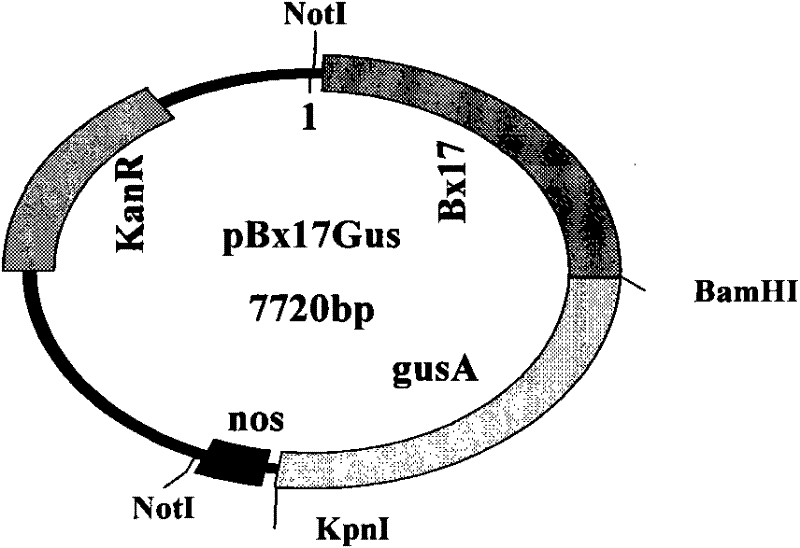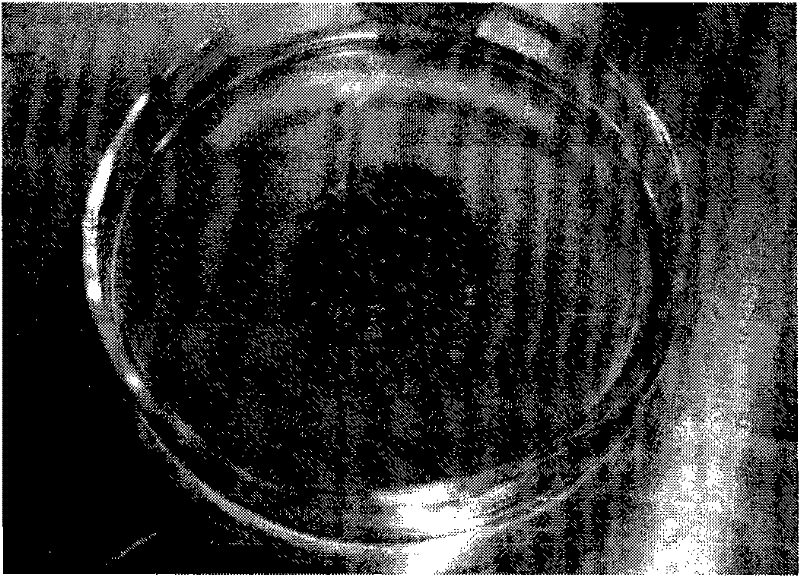A transgenic method using wheat anthers as receptors
A technology of transgenic plants and receptors, applied in the field of transgenic, can solve the problems of complex chromosome composition and slow stability of transgenic offspring, and achieve the effect of improving the efficiency of resource innovation
- Summary
- Abstract
- Description
- Claims
- Application Information
AI Technical Summary
Problems solved by technology
Method used
Image
Examples
experiment example 1
[0038] Experimental example 1, transformation of anther by gene gun
[0039] 1. Separation and pretreatment of anthers
[0040] 1. Preparation of 0.3M mannitol pretreatment solution: Weigh 54.65 grams of analytically pure mannitol, dissolve it in 1000 ml of ultrapure water, and after autoclaving, add 200 mg of cephalosporin sterilized by suction filtration per liter.
[0041] 2. Preparation of medium for anther callus induction: solid medium was poured three days in advance, 200 mg of cephalosporin was added per liter, poured into a 3.5 mm culture dish, and the culture medium plate was checked for contamination. The specific formula is shown in Table 2.
[0042] 3. The wheat anther donor variety is K35, observe the anther development period under a microscope, and take figure 2 The anthers at the single-nuclei margin stage as shown (at this time, the top of the ear is about 10cm away from the flag leaf auricle), put them into a petri dish filled with 0.3M mannitol pretreatme...
experiment example 2
[0057] Experimental example 2. Anther recovery culture and selection of regenerated seedlings and chromosome doubling
[0058] 1. Anther recovery culture and selection of regenerated seedlings
[0059] 1. Put the bombarded anthers in the aseptic operating table, press Figure 4 The method shown was transferred to the callus induction medium, and after 3 days of dark culture at 32°C, it was changed to dark culture at 28°C for about 4 weeks to obtain embryoid bodies.
[0060] 2. Transfer the embryoid bodies of about 1 to 2 mm to the regeneration medium added with G418 (the G418 in the regeneration medium shown in Table 2 should be filtered and sterilized and added to the regeneration medium after autoclaving), and light Intensity 5000lux, 16 hours of light per day at 25°C for regeneration culture, see Figure 5 .
[0061] 3. Transfer the regenerated green shoots to 1 / 2 MS medium added with 25 mg / L G418, and continue to screen for 2 weeks.
[0062] 2. Strong seedling cultivat...
experiment example 3
[0071] Experimental example 3. Analysis of Gus gene expression in transgenic offspring
[0072] 1. Preparation of Gus tissue staining solution mother solution: 0.2M sodium phosphate buffer; 200mg X-gluc dissolved in 400ul DMSO; 0.1M potassium ferrocyanide; 0.1M potassium ferricyanide; 0.5M Na2- EDTA
[0073] 2. Preparation of Gus tissue staining solution: 1000ml of 0.2M sodium phosphate buffer; 1ml of 0.1M potassium ferrocyanide and 0.1M potassium iron cyanide; 8ml of 0.5M Na2-EDTA; dissolved in DMSO 200mg X-gluc in water; 90ml water, dilute to 200ml.
[0074] 3. Gus tissue staining: Take the tissue to be tested, cut or cut it, put it into a 5ml centrifuge tube, completely submerge it in Gus staining solution, shake overnight at 37°C, wash it with 70% ethanol 2~3 times the next day, Observe the gus gene expression intensity.
[0075] Such as Figure 8 , Figure 9 B and Figure 10 Shown in A, transform the positive plant of pCAMBIA1301, its grain ( Figure 8 ),root tip( ...
PUM
 Login to View More
Login to View More Abstract
Description
Claims
Application Information
 Login to View More
Login to View More - R&D
- Intellectual Property
- Life Sciences
- Materials
- Tech Scout
- Unparalleled Data Quality
- Higher Quality Content
- 60% Fewer Hallucinations
Browse by: Latest US Patents, China's latest patents, Technical Efficacy Thesaurus, Application Domain, Technology Topic, Popular Technical Reports.
© 2025 PatSnap. All rights reserved.Legal|Privacy policy|Modern Slavery Act Transparency Statement|Sitemap|About US| Contact US: help@patsnap.com



